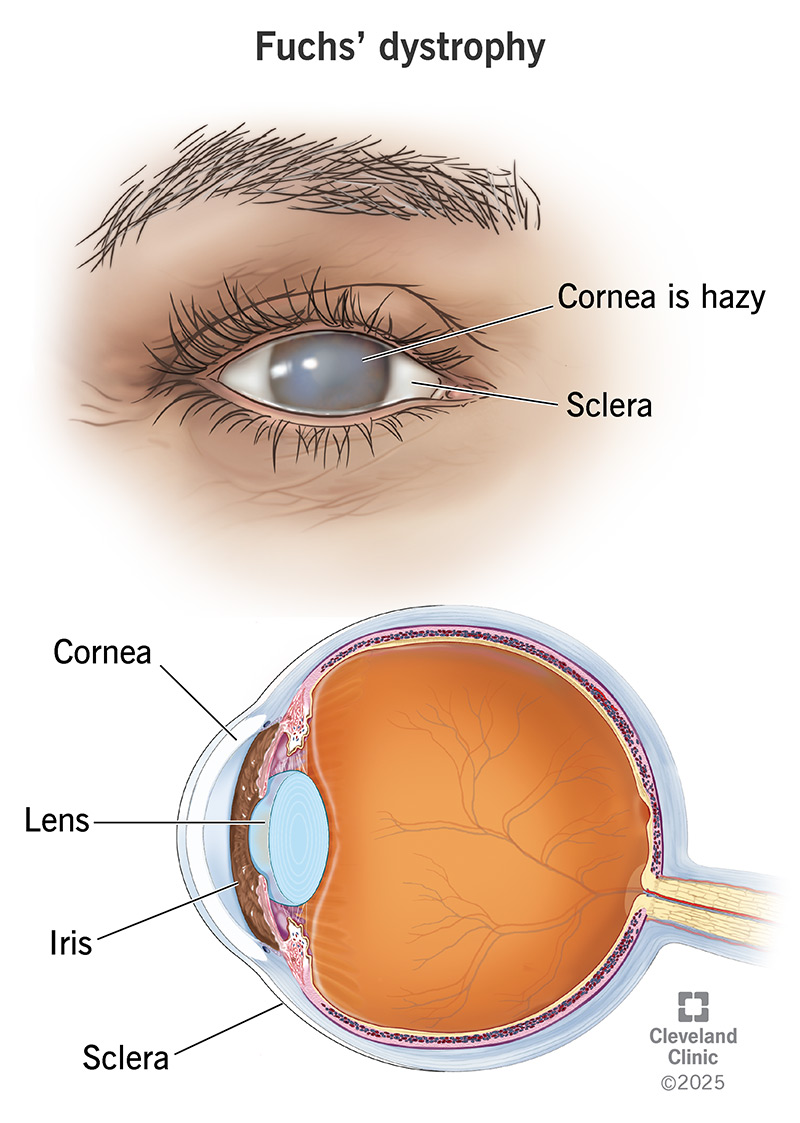Fuchs’ dystrophy is an eye disease that affects your corneas. In this disease, certain cells in your corneas die off, causing your corneas to swell with fluid. This can cause blurred vision. Without treatment, it could lead to vision loss. Depending on how severe it is, your provider may recommend a corneal transplant.
Advertisement
Cleveland Clinic is a non-profit academic medical center. Advertising on our site helps support our mission. We do not endorse non-Cleveland Clinic products or services. Policy

Image content: This image is available to view online.
View image online (https://my.clevelandclinic.org/-/scassets/images/org/health/articles/fuchs-dystrophy)
Fuchs’ dystrophy (pronounced “fyooks DI-struh-fee”) is a disease that usually affects the corneas of both of your eyes. Your cornea is the clear, tough, protective tissue that covers your iris and pupil. Other names for this corneal dystrophy are Fuchs’ corneal dystrophy and Fuchs’ endothelial dystrophy.
Advertisement
Cleveland Clinic is a non-profit academic medical center. Advertising on our site helps support our mission. We do not endorse non-Cleveland Clinic products or services. Policy
In Fuchs’ dystrophy, your corneal endothelium (the innermost layer of your cornea) gradually stops working as cells die. When it’s healthy, your endothelium acts like a pump to remove fluid from your cornea so it stays clear.
As your endothelium cells stop working, your cornea may swell from excess fluid, which can cause blurred vision or a haze over your eye. Small blisters may appear on the surface of your cornea, causing pain and irritation.
The two main stages of Fuchs’ corneal dystrophy are:
In the early stage, you might not have any symptoms. If you do have an early symptom, it might be that your vision is blurred in the morning but gets better as the day goes on.
Later, Fuchs’ endothelial dystrophy symptoms may include:
Advertisement
You can inherit Fuchs’ dystrophy from one of your biological parents during conception (autosomal dominant inheritance). But some cases happen randomly (sporadically) without a history of the condition in your biological line.
Some things can make Fuchs’ corneal dystrophy worse, including:
Certain factors can determine whether you have an increased risk for developing Fuchs’ dystrophy. These risk factors include:
An eye care specialist will begin by taking a medical history, asking questions about your symptoms and doing a thorough eye exam.
Your provider will be able to see things in your eye exam that will point to a diagnosis of Fuchs’ dystrophy. These include:
Your provider may use the following tests to diagnose Fuchs’ dystrophy:
A healthcare provider can treat Fuchs’ endothelial dystrophy, but they can’t cure it. Your provider may choose observation during the early stage. Other Fuchs’ dystrophy treatments may include:
Advertisement
It’s important to develop a good relationship with your eye care specialist. Keep your scheduled appointments and contact them if you have any new or worsening symptoms.
You may want to ask your provider:
Depending on how severe it is, Fuchs’ dystrophy may cause extreme pain, low vision or blindness if you don’t seek treatment.
With treatment, your expected outcome is much better. Your vision may improve to 20/20 within days of surgery (with glasses). That’s why it’s important to work with your provider to find the right treatment for you.
There’s currently no way to prevent Fuchs’ corneal dystrophy. But you can help yourself by quitting smoking if you do smoke. If you have diabetes, work with your healthcare provider to manage your blood sugar levels.
Experiencing symptoms of any eye condition can be scary, and that’s true of Fuchs’ dystrophy. If you do have symptoms like pain or blurred vision, see a healthcare provider as soon as possible. Remember that early detection and treatment often offer the best outcome. Researchers continue to develop new ways to manage and treat Fuchs’ corneal dystrophy and other conditions.
Advertisement
Learn more about the Health Library and our editorial process.
Cleveland Clinic's health articles are based on evidence-backed information and review by medical professionals to ensure accuracy, reliability, and up-to-date clinical standards.
Cleveland Clinic's health articles are based on evidence-backed information and review by medical professionals to ensure accuracy, reliability, and up-to-date clinical standards.